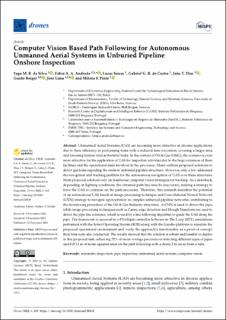| dc.contributor.author | da Silva, Yago M. R. | |
| dc.contributor.author | Andrade, Fabio Augusto de Alcantara | |
| dc.contributor.author | Sousa, Lucas | |
| dc.contributor.author | de Castro, Gabriel G. R. | |
| dc.contributor.author | Dias, João T. | |
| dc.contributor.author | Berger, Guido | |
| dc.contributor.author | Lima, José | |
| dc.contributor.author | Pinto, Milena F. | |
| dc.date.accessioned | 2023-04-28T09:14:35Z | |
| dc.date.available | 2023-04-28T09:14:35Z | |
| dc.date.created | 2023-01-09T10:04:41Z | |
| dc.date.issued | 2022 | |
| dc.identifier.citation | da Silva, Y. M. R., Andrade, F. A. A., Sousa, L., de Castro, G. G. R., Dias, J. T., Berger, G., Lima, J. & Pinto, M. F. (2022). Computer Vision Based Path Following for Autonomous Unmanned Aerial Systems in Unburied Pipeline Onshore Inspection. Drones, 6(12), Artikkel 410. | en_US |
| dc.identifier.issn | 2504-446X | |
| dc.identifier.uri | https://hdl.handle.net/11250/3065455 | |
| dc.description.abstract | Unmanned Aerial Systems (UAS) are becoming more attractive in diverse applications due to their efficiency in performing tasks with a reduced time execution, covering a larger area, and lowering human risks at harmful tasks. In the context of Oil & Gas (O&G), the scenario is even more attractive for the application of UAS for inspection activities due to the large extension of these facilities and the operational risks involved in the processes. Many authors proposed solutions to detect gas leaks regarding the onshore unburied pipeline structures. However, only a few addressed the navigation and tracking problem for the autonomous navigation of UAS over these structures. Most proposed solutions rely on traditional computer vision strategies for tracking. As a drawback, depending on lighting conditions, the obtained path line may be inaccurate, making a strategy to force the UAS to continue on the path necessary. Therefore, this research describes the potential of an autonomous UAS based on image processing technique and Convolutional Neural Network (CNN) strategy to navigate appropriately in complex unburied pipeline networks contributing to the monitoring procedure of the Oil & Gas Industry structures. A CNN is used to detect the pipe, while image processing techniques such as Canny edge detection and Hough Transform are used to detect the pipe line reference, which is used by a line following algorithm to guide the UAS along the pipe. The framework is assessed by a PX4 flight controller Software-in-The-Loop (SITL) simulations performed with the Robot Operating System (ROS) along with the Gazebo platform to simulate the proposed operational environment and verify the approach’s functionality as a proof of concept. Real tests were also conducted. The results showed that the solution is robust and feasible to deploy in this proposed task, achieving 72% of mean average precision on detecting different types of pipes and 0.0111 m of mean squared error on the path following with a drone 2 m away from a tube | en_US |
| dc.language.iso | eng | en_US |
| dc.rights | Navngivelse 4.0 Internasjonal | * |
| dc.rights.uri | http://creativecommons.org/licenses/by/4.0/deed.no | * |
| dc.title | Computer Vision Based Path Following for Autonomous Unmanned Aerial Systems in Unburied Pipeline Onshore Inspection | en_US |
| dc.type | Peer reviewed | en_US |
| dc.type | Journal article | en_US |
| dc.description.version | publishedVersion | en_US |
| dc.rights.holder | © 2022 by the authors. | en_US |
| dc.source.pagenumber | 19 | en_US |
| dc.source.volume | 6 | en_US |
| dc.source.journal | Drones | en_US |
| dc.source.issue | 12 | en_US |
| dc.identifier.doi | https://doi.org/10.3390/drones6120410 | |
| dc.identifier.cristin | 2103006 | |
| dc.source.articlenumber | 410 | en_US |
| cristin.ispublished | true | |
| cristin.fulltext | original | |
| cristin.qualitycode | 1 | |

